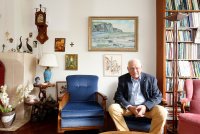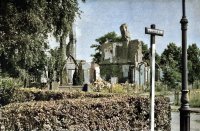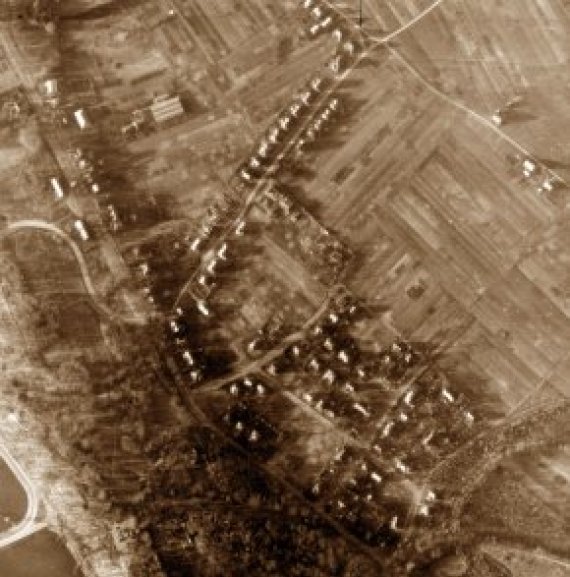The Sahara after the bombardment. Some of the houses were destroyed and there were countless bomb craters in the ground.
text Roelof Kleis
‘It was a lovely autumnal day. The kind with mist between the trees and a beautiful blue sky.’ Co de Bruijn (83) talks as if it were yesterday. But the day he is describing was 75 years ago. ‘There were a lot of planes in the air,’ he recalls. It was on that Sunday, 17 September 1944 that the Battle of Arnhem began. After four years of German occupation, the prospect of liberation was in the air. ‘I can still remember my mother calling out excitedly that morning: boys, boys, the Tommies (British soldiers, ed.) are coming!’
Gathering chestnuts
Co de Bruijn was eight years old at the time. He was the second of the four sons of Evert de Bruijn (then 44), clerk at the sub-district court in Wageningen, and Didy Vonk. Evert was at church that morning with his eldest son Jan (10). Because of the commotion, Didy stayed at home that morning with Co and his little brothers Rudy (7) and Dicky (4). But the weather was far too nice to stay indoors. ‘It was my idea,’ says De Bruijn, ‘to go with Rudy to gather chestnuts on the main road (now the Generaal Foulkesweg, ed.). My little brother Dicky wanted to come along too. And he was allowed to! I can still hear my mother saying, “And take good care, won’t you?’ It probably saved his life.’
That he was allowed to go chestnut-gathering probably saved my little brother’s life
The boys were gathering chestnuts when suddenly all hell broke loose. ‘Bombs whining, shell fragments and broken branches flying through the air, houses on fire all around us, and the sound of screaming and wailing,’ was how De Bruijn described the inferno in the story he read out at the unveiling of the monument for the victims of the bombardment on the Ericaplein. The boys took cover in a ditch on the Westbergweg.

Ex-WUR employee Co de Bruijn was eight when his mother died in the bombardment of the Sahara neighbourhood in Wageningen.
Wall blasted away
Co de Bruijn never saw his mother again. Her badly wounded body was found outside the door of the utility room. The wall had been blasted away, but the washing up stood undamaged on the drying rack, writes Reinder Elders in his little book Bommen en Bouwen op de Wageningse Berg (Bombs and Building on Wageningen Hill). The book came out 25 years ago, 50 years after the bombardment, which had all but been forgotten by then.
The De Bruijn family were evacuated and put up at a farm in Voorthuizen. There Co discovered farm life. ‘I loved it. The farmer told my father: that boy should become a farmer, he’s got it in him.’ For years after the war, De Bruijn spent his school holidays on the farm, but it quickly became clear that going into farming was not an option. ‘You need capital for that, and we didn’t have that.’

The Ericalaan after the bombardment.
Anxious times
Co’s father Evert got married again after the war and got a job at the district court in Arnhem. Two more children were born. Then came the next blow, when Evert died suddenly of a heart attack at the age of 49. ‘They were anxious times. My stepmother was on her own with six children and no funds to fall back on.’
Co de Bruijn didn’t go into farming, but he was always drawn towards nature. After secondary school, vocational training in horticulture and the Dutch Wood Academy, he got a job in Wageningen as manager of the then Agricultural College’s Herbarium. He ended up working for WUR for nearly 40 years. The plant collection grew tremendously in that time. ‘From fewer than 100,000 plants when I started to between 500,000 and 600,000 when I left.’ There is no Wageningen Herbarium now: the collection has been moved to Naturalis in Leiden.
A monument at last
The untimely loss of his mother and father left its mark, of course, but Co de Bruijn does not look back in bitterness. In fact, the events made him all the more determined to take a positive attitude in life. ‘What happened, happened. You can’t change the past. You can give up in despair but that doesn’t solve anything. You have to have initiative and make something of it yourself. And I have done that. I am a self-made man. My life has had its ups and downs but there have been far more ups than downs.’
Last Tuesday, De Bruijn was at the unveiling of the new monument in the Sahara. ‘It’s not difficult for me to be back in the neighbourhood. I can enjoy walking around it. But I do feel that it has a big effect on me. I am pleased there is a monument at last.’
Professor in hiding lost wife and child
The Sahara neighbourhood on the Wageningen Hill bordering the Belmonte Arboretum was still relatively new in 1944. Several professors at the Agricultural College had moved in there. At 11.37 on Sunday 17 December of that year, 160 bombs fell on the neighbourhood. This was an error: the bombs were intended for the German guns that were positioned 500 metres away at the Lexkes ferry.
All the professors who lived in the neighbourhood survived the bombardment, but professor of Organic Chemistry Simon Olivier lost his wife Maria Haitsma and their 19-year-old son Tim. They were killed in front of their house at number 14 Bergstraat, now 14 Boeslaan. Olivier himself was living in hiding in the Betuwe area at the time. He had been arrested in July 1945 for having German posters removed from the windows of the main building of the Agricultural College. He was detained for 11 months, part of the time in the concentration camp in Amersfoort, and went into hiding after his release. Olivier was the first post-war rector of the Agricultural College. He lived in the house on the Bergstraat until he died in 1961.

